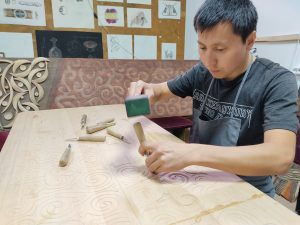
Artistic woodworking
One of the main products of woodworkers was the Kazakh yurt, which consists of a wooden frame and felt cover. The largest yurt was the ten-channel yurt, called the Khan’s yurt, and the most common type was the six-wings yurt. A wing is a prefabricated lattice, several wings connected to each other make up the wall of a kerege yurt. Uyq are the domed poles and shanyraq is the circular top of the yurt. Masters used to make magnificent double doors – esik. According to folk omens, a master who made the yurt frame never started making a door, otherwise he would die prematurely.
However, the whole process of making wooden items was strictly regulated by certain rites and rituals, and the wood itself was revered as sacred. Wooden craftsmen also made beautiful furniture, with carvings, inlays of bone and metal, and paintings. Unique examples of wooden furniture – the tösekağash – bed, the kebezhe – grocery box, the sandyq – chest, the zhükayaq –
stand, and the adalbaqan – pole-hanger – are preserved in the collections of domestic and foreign museums, astonishing them with their exquisite décor.
Each of the items was deliberately decorated with a magical pattern, which almost always meant a wish for abundance, prosperity. In principle, furniture in the yurt was the most active aesthetic component of the interior.
The most exquisite examples of ornamented and inlaid furniture belonged to well-to-do families. Such furniture was richly ornamented with flat-relief, contoured or three-sided carvings. Craftsmen often used wood staining and painting to enhance the effect of the carved pattern, and beeswax was also used.
The composition of patterns on wooden items was usually of several types. One type was a centric arrangement, the next was an axial composition with rhythmic alternation of patterns in the form of a frieze, a grid arrangement – a continuous covering of the entire surface of the piece, and a repetitive composition with repeating elements.
Virtually all patterns carried semantic meaning but among particular significance is the bitpes pattern, which translates as infinite. It reflected the ideas of the infinity of life, eternal movement and the interconnectedness of everything in this world.
Yurt doors were made of birch, poplar or Karagai (pine) boards. Structurally, they could also be paneled. The art of making traditional furniture and doors out of wood was active as late as the mid-20th century.
For example, the private collection of the famous jeweller and connoisseur Serzhan Bashirov contains original yurt doors and examples of traditional furniture – kebezhe, sandyq, etc. Unfortunately, at the moment the production of traditional furniture has practically come to naught.
However, modern craftsmen predominantly create interior design objects and furniture for ethno-restaurants and cafés.
Among modern companies worth mentioning is the Kokshetau-based Black Manufacturing Company, which produces wooden items in the Kazakh national style. These include a round table on low legs, a traditional cradle – besik, tableware – various types of astau, kumys kits, chests and kebezhe, dombra cases, wall panels and much more. The products are in demand by a wide range of consumers. However, the company does not manufacture authentic, indigenous traditional items, which could be an important contribution to the preservation of this type of intangible cultural heritage. The Kostanay company KBK, also involved in production of yurts and designer furniture with ethnical design, is one of the notable brands.
The yurt’s frame and doors are also at risk. The yurts manufactured in China, which are based on metal construction and synthetic insulation, are a huge competition to local craftsmen. Such yurts are more economical for consumers and require less storage than traditional dwellings. In this aspect, it seems that Kazakhstan should long ago apply Uzbekistan’s experience and ban imports of such products from other countries, including souvenirs.
Almost unique in its kind is considered a company (national house) “Nomadiks”, which unites unique masters, able to make a complex set from the yurt itself to its interior decoration. One workshop of the team is located in Kasyk village in Zhambyl region, the other in Bishkek (Republic of Kyrgyzstan).
Another enterprise that qualifies in the manufacture of yurts in both traditional and modern technologies is the Kostanay enterprise headed by Aidar Bisembaev.
Among the individual craftsmen engaged in the production of Kazakh yurts, Malik Gusmanov stands out.
Several years ago in the East Kazakhstan region, in Zyryanovsk, entrepreneur Yernar Kasymkhanov opened a mini-shop for the production of traditional Kazakh yurts. The construction of this enterprise’s yurt is based on birch bark. It is thought that the entrepreneur will succeed in realizing all his plans and the enterprise will become the leading one in the region.
In recent years traditional wooden crockery, which is made by many masters in Kazakhstan, has become very popular with the population. But among them there are unique masters. For example, Nurlan Zhakybaev from Aktobe region has been creating tableware made by traditional method for more than 25 years.
Medetbay Omarov, a craftsman from Korday district of Zhambyl province, is also famous for his woodwork. He makes tableware and musical instruments.
Taldykorgan entrepreneur Abzal Begimbetov has set up a whole shop for the production of traditional wooden crockery, and as a copyright reservation the ancient Kazakh ornament ükiköz is applied to each product of the shop. Thus, this ornament has become a hallmark of the enterprise.
The products of another master from Bulandinsky district of Kokshetau region are also in great demand. The assortment of products is quite wide: special dishes for meat – astau, dishes for making qürt, separately for milk and gymyz.
When considering such an area as artistic woodworking, one cannot but mention the work of Saule Musaeva. Her work can be called a creative interpretation of Kazakh traditions. For more than 30 years she has been creating wooden dolls, “dressed” in Kazakh ethnographic costume that corresponds to a certain epoch and a particular region.
The range of woodworkers’ products also includes a traditional baby cradle, the besik. It is a valuable Kazakh family relic, handed down from generation to generation. Archaeological artefacts suggest that the manufacture and use of such a cradle was already practiced in the early Middle Ages. Artifacts found at excavations in Otyrar ( 12th-14th centuries) and Qūyryq-tobe ( 10th-12th
centuries) in South Kazakhstan bear witness to this.
The design of the besik has hardly changed since long ago. As it used to be, it is a fairly simple and mobile rocking structure. The cradle is made of willow, birch or other easily bent types of wood. The main structural elements of the cradle are the body (with an opening), the rounded slats and the arched lower slats attached to both backrests for rocking. The backrests of the cradle are connected by a crossbar acting as a handle. The base of the cradle has a special opening under which there is an attached pot where the baby’s urine escapes through a bone tube – shümek.
Very often the backs and handle of the besik – cradle are decorated with carved ornaments, and sometimes for the wealthier ones with inlaid stones, silver or other metals. The textile decoration of the cradle deserves special attention and its harmonious image is supplemented with all kinds of amulets against evil spirits and evil eye. These can be owl feathers, wolf’s claws, etc. The very tradition of making and using the cradle Besik is accompanied by a system of rituals, customs and taboos.
Today, we can state that this element of ICH is at risk. The fact is that domestic markets are literally oversaturated with cradles made by Uzbek and Kyrgyz craftsmen. This certainly reduces their domestic production and the interest of craftsmen in this type of craft.
Another, and fortunately growing, area of artistic woodworking is the art of making Kazakh traditional musical instruments out of wood. These are the dombyra, qobyz and zhetygen. The Kazakhs call the dombyra the queen of musical instruments and often say: “nağyz qazaq qazaq emes, nağyz qazaq dombyra”.
The Kazakh dombyra is a favourite and widespread musical instrument. It is played by children and adults alike. Light, compact and simple in construction, it offers great opportunities to express the musical genius of the Kazakh people and enrich the sound palette of their compositions.
Masters emphasise that different types of wood produce different sounds. Thus, depending on the type of wood and the types of strings, leather or wood decks “add up” to unique music and acoustic systems with specific timbre and sound characteristics.
The modern masters include Zholaushy Turdygulov, Omar Rukhanov, Erdos Rakhimbekov, Abilkasym Baibulanov, Amangeldy Smagulov, Nurbek Okanov and many others. Masters who make dombyras usually have other musical instruments made of wood, such as the qobyz, a sacred instrument according to the Kazakhs.
This element of intangible cultural heritage is active and functioning. However, it should be noted that the technology of making natural strings from the intestines of domestic animals has practically disappeared. Unfortunately, craftsmen do not use these natural strings nowadays due to their complicated production technology. The material (intestine) must necessarily be fresh. The
process of cleaning the gut itself is very time consuming which includes preparing a strengthening composition from a set of herbs, ensuring proper drying, etc. No less time-consuming and complicated is the process of making such a string, which
requires a high degree of skill (difficulty in achieving the desired string diameter).
For this reason, polymer strings have been used everywhere since the end of the 20th century, which are intended for orchestral music. But, it is natural strings that demonstrate authentic sounding of an instrument in traditional qoñyr timbre. Well-known Kazakh ethnomusicologist S.I.Utegalieva calls this timbre a polysemantic notion, which concentrates a whole system of philosophy.
At the moment, there are only a few masters of natural strings left in the country. These are the Aktobe master Erkosai Abilov, the Almaty master Zholaushy Turdygulov and others.
Orteke, a traditional music-and-puppet art, is also gaining popularity today, using a wooden tauteke goat figurine tied by thread to the musician’s finger. It depends on the performer-musician and the skill of the maker how rhythmic and agile the goat figure is in its dance.
A stunning example of a peculiar steppe theatre was made by Almas Mustafa, a wood master already well-known in Kazakhstan and abroad. He was deservedly awarded the Grand Prix and the President’s Cup for his “Orteke” at the “Shabyt” competition for creative youth, and also won the “Sheber” competition for artisans.
To conclude this brief review of contemporary art of woodworking, we should also note the work of young master Rafael Tulegenov, who has mastered the traditional art of bow-making.
All in all, by individual branches of artistic woodworking is a living heritage. But, the art of making wooden yurts and traditional furniture needs urgent protection and comprehensive support.




